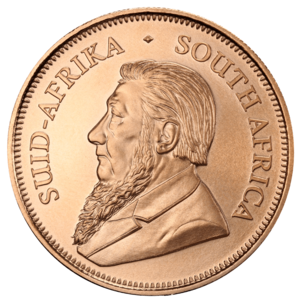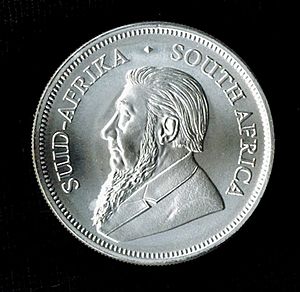Krugerrand facts for kids
| South Africa | |
| Value | 1 troy oz. fine gold |
|---|---|
| Mass | 33.93 g (1.09 troy oz) |
| Diameter | 32.77 mm (1.28 in) |
| Thickness | 2.84 mm (0.11 in) |
| Composition | Gold (91.67% Au, 8.33% Cu) |
| Years of minting | 1967–present |
| Obverse | |
 |
|
| Design | 1892 by Otto Schultz – Profile of Paul Kruger with "SUID‑AFRIKA · SOUTH AFRICA" in the legend |
| Reverse | |
 |
|
| Design | 1947 by Coert Steynberg – A pronking springbok antelope with the mint date in the field. The legend is inscribed with "KRUGERRAND" and the gold weight. |
The Krugerrand is a famous South African coin. It was first made on July 3, 1967. The main goal was to help sell gold from South Africa to the world.
The coin's name comes from two parts. "Kruger" is from Paul Kruger, who was a president of South Africa a long time ago. His picture is on one side of the coin. "Rand" is the name of South Africa's money.
On the other side of the Krugerrand, you'll see a springbok. This animal is a type of antelope and is South Africa's national animal.
By 1980, the Krugerrand was very popular. It made up over 90% of all gold coins sold globally. Many people who wanted to buy gold chose the Krugerrand.
However, in the 1980s and 1990s, some countries stopped buying Krugerrands. This was because of South Africa's apartheid policy. Apartheid was a system of unfair rules that separated people by race.
Even though gold Krugerrands don't have a number printed on them like regular money, they are still considered real money in South Africa. This means you could use them to buy things, though most people collect them or save them as an investment.
In 2017, the Rand Refinery started making Krugerrands from silver too. These silver coins look just like the gold ones.
Contents
History of the Krugerrand
The Krugerrand was created in 1967. It was made so that regular people could own gold easily. The coin is made from a mix of gold and copper. This makes it stronger than pure gold.
By 1980, the Krugerrand was a huge success. It controlled 90% of the world's gold coin market. That year, South Africa also started making smaller Krugerrands. These coins had half, a quarter, or a tenth of an ounce of gold.
During the 1970s and 1980s, many Western countries stopped importing Krugerrands. This was because of economic sanctions against South Africa. These sanctions were a way to protest the country's apartheid policies. The United States, which was the biggest buyer, banned them in 1985. Before that, over $600 million worth of Krugerrands were sold in the US in just one year.
Most of these bans were lifted in 1991. This happened after the South African government started to end its apartheid policies. Even during the bans, South Africa found ways to sell the gold. For example, some Krugerrands were melted down in other countries and turned into new gold products.
Since 1967, more than 50 million ounces of gold Krugerrand coins have been sold. That's a lot of gold!
Other Gold Coins and the Krugerrand
The Krugerrand's success in the 1970s inspired other countries. Many gold-producing nations decided to make their own gold coins. They wanted to attract investors too.
For example, Canada launched the Canadian Gold Maple Leaf in 1979. China created the Chinese Gold Panda in 1982. The United States introduced the American Gold Eagle in 1986. Australia and Britain also made their own gold coins.
What Makes a Krugerrand Special?
The front side of the coin is called the obverse. It shows the face of Paul Kruger. He was a famous leader and president of the old South African Republic. This design was created by Otto Schultz.
The back side of the coin is called the reverse. It shows a springbok, which is South Africa's national animal. This design was made by Coert Steynberg. This springbok image was used on other South African coins before.
The coin also has "South Africa" and the gold content written on it. This text is in both Afrikaans and English.
The name "Krugerrand" is a special trademark. It belongs to the Rand Refinery Limited.
Special Collector's Krugerrands
The South African Mint Company makes special Krugerrands. These are called proof coins. They are made for collectors, not just for their gold value. These coins cost more than regular Krugerrands.
You can tell a proof coin from a regular one by looking at its edge. Proof coins have 220 tiny ridges on their edge. Regular coins have 160 ridges.
50th Anniversary Coins
In 2017, the Krugerrand celebrated its 50th birthday. To mark this special event, the South African Mint made new versions. They created "Premium Uncirculated" coins in gold. For the first time, they also made them in platinum and silver.
These special anniversary coins have a small "50" mark. This mark is near the springbok design. It helps people know they are the special anniversary editions.
Taking Krugerrands Out of South Africa
If you live in South Africa, there are rules about taking Krugerrands out of the country. You can only take a certain amount of them when you travel.
Visitors to South Africa can take up to 15 coins with them. But they need to tell the South African tax service about them.
Krugerrands for Charity
In recent years, Krugerrands have been in the news in the United States. This is because some people have secretly dropped these valuable coins into Salvation Army donation buckets. These donations happen around Christmas time. It's a generous way to help others.
See also
- Bullion
- Bullion coin
- Economy of South Africa
- Gold as an investment
- Inflation hedge
- Silver as an investment
- Mosi-oa-Tunya (coin)


